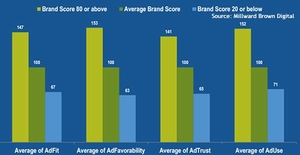Commentary
Putting Programmatic In Context
- by Tyler Loechner , Staff Writer @mp_tyler, June 25, 2014
 Is
“context” -- the content of an ad in relation to the content of the Web site it’s placed on -- a lost art when it comes to programmatic buying -- or more specifically,
audience-buying?
Is
“context” -- the content of an ad in relation to the content of the Web site it’s placed on -- a lost art when it comes to programmatic buying -- or more specifically,
audience-buying?
A new report from Millward Brown Digital, a company that specializes in helping Web publishers grow their brand image, suggests that programmatic advertisers sometimes “ignore” place, or context.
“Audience-based buying is quickly becoming a core component of advertisers’ media buys,” stated Stephen DiMarco, chief marketing officer and chief client officer at Millward Brown Digital. “While it certainly offers the opportunity to reach audiences more efficiently, our research shows that advertisers can't ignore the strength of the publisher's brand as a fundamental part of the ad experience and overall effectiveness of the campaign.”
Millward graded 44 sites across five categories -- including Finance, News, Sports, Food and Portals -- between 0 and 100 based on each site’s brand “power, perceptions and differentiators.”
According to
Millward, as the “Brand Score” went up, so did the fit of advertisements, the consumers' enjoyment of the ads, the trust consumers placed in the ads and the usefulness of the ads. Millward
based its ratings on behavioral and attitudinal data collected about the consumers that visited the 44 sites during February 2014.
See the inset chart. (The figures represent the “fit, favorability, trust and use” of the ads relative to the average, so a score of 147 means it is 47% above average.)
Of course, these findings might help Millward Brown Digital, but the buy-side’s behavior suggests the company has a point.
According to [x+1], a demand-side platform (DSP), buyers are not ignoring context when running audience-based campaigns. In fact, context is becoming more important.
“The importance of context for marketers is something that we see growing,” said Eli Carreiro, director of strategy and analytics at [x+1]. “We now use contextual category targeting across all open RTB buys. Ads are not served without being contextually categorized.” (The company recently updated its data management platform for this specific purpose.)
“Content can be avoided, i.e. alcohol,” said Carreiro. He noted that while “context was never ignored altogether,” it has come up in discussions with advertisers more frequently of late. “Because context can significantly increase the relevance of a brand’s message, we believe it’s a trend that will continue.”
Now back to the opening question: Is context a lost art when buying audiences via programmatic?
The ultimate answer is no, context is not a lost art in programmatic. Some marketers do ignore it when buying audiences, but not many. According to Carreiro, “nearly 100%” of the campaigns [x+1] sees take context into account.
After all, isn’t programmatic all about reaching the right person, at the right time, in the right place?




Smart buyers aren't just embracing context - smart buyers are expanding the definition of context to look at environmental attributes of each page. Number of ads per page, where on the page the ad is relative to the content, the sentiment of the content....all of these and more define the most important question of all once you move beyond the cookie: is that ad call, on that page at that moment, the right environment for the brand? Good platforms (like ours here at PulsePoint) unlock that data and are improving both transparency and yield for both parties involved. Transparency & environment are the real bridges that will move RTB well beyond the cookie and CPM's up to fair market value for all involved.